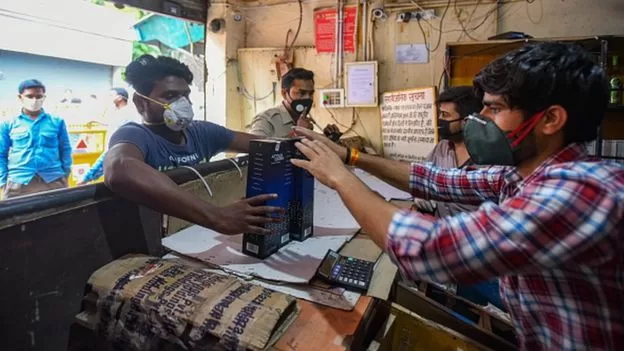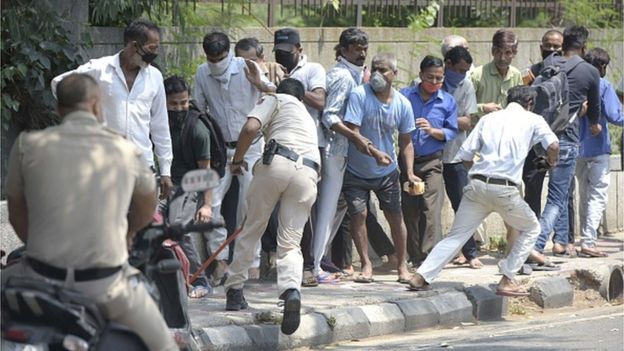The Reality Behind India’s Post-Lockdown Frenzied Liquor Sales

When India eased the lockdown, which had been put in place to prevent the spread of Covid-19, in some cities in the second week of May, an incredible sight was seen across the country. There were long queues outside liquor shops, some stretching up to 2 or 3 kilometres.
In some cities, the government had to shut the shops again, because customers made a mockery of social distancing in their enthusiasm to get their booze. Some places, police had to lathi charge to control the unruly crowds.

The frenzied rush was expected: the strict lockdown has fuelled a pent-up demand for booze. This spike in alcohol sales is apparently a global phenomenon. In the UK, sales saw a jump of 22% in March and in the USA, it was 55% more compared to the same period last year.
Selling alcohol has always been a tough task in India. Limited retail outlets which require cumbersome licensing are the only way, since home deliveries and e-commerce are not allowed. Several state governments keep imposing total prohibition as a vote capturing measure. Each of the 29 states has its unique policy for control, sale, pricing and taxation on booze.
The grim scenario of India’s growing alcohol consumption
Despite all the constraints, India continues to be the second-largest consumer of alcohol in the world, according to IWSR Drinks Market Analysis, a UK-based research organisation. As per-capita consumption of alcohol is rising, it is estimated that the country consumes over 663 million litres of alcohol per year – that’s 11% more than 2017.
India’s consumption of whiskey is the highest in the world – about thrice the amount consumed by Americans – US is the second biggest consumer. Nearly one in every two bottles of whiskey sold in the world is purchased in India.
More than 45% of the liquor sold in India is in five southern states – Andhra Pradesh, Telangana, Tamil Nadu, Karnataka and Kerala. These states earn 10% of their revenue from taxes on liquor sales, according to Crisil, a research and rating firm.
The other top six states with high liquor consumption – Punjab, Rajasthan, Uttar Pradesh, Madhya Pradesh, West Bengal and Maharashtra – earn between less than five to 10% of their revenues from liquor sales. The other states too earn significant revenue from liquor-related trade, including license fees.
“But not a drop was sold in April, and given the dire state of their revenues, these states have been anxious to make good their losses by opening up the liquor vends,” as reported by Crisil, the research agency. Lack of liquor taxes greatly dented the financial health of the states, in addition to other losses and increased expenditure due to Covid-19 crisis.
One-third of Indian men drink alcohol, according to a government report. Over 14% of Indian citizens aged between 10- and 75-years drink. 11% of these are binge-drinkers, according to a WHO estimate (the global average is 16%).
A matter of concern is that a third of these drinkers consume cheap and unregulated local brew. Country liquor has caused several tragedies, since it is often adulterated with spurious stuff. According to a report, nearly 20% of drinkers are dependent on spurious liquor.
According to WHO, half of the alcohol consumed in India is “unrecorded”. The locally brewed alcohol is neither recorded nor taxed in most states.
Now here’s the big news: Indians are drinking more alcohol than ever. A recent study of liquor consumption in 189 countries between 1990 and 2017 found that consumption in India had grown from 4.3 litres to 5.9 litres per adult annually – a rise of 38%.
In 2012, a third of all road accident deaths in India were due to drunk driving. According to the National Mental Health Survey (2015-16), nearly 10% of adult men were identified as addicted to alcohol. Over 60% of deaths related to cirrhosis of liver were linked to alcohol consumption. Alcohol consumption has emerged as a major public health problem. As is inevitably the case, women and children are the most affected by alcoholism in the family. Domestic violence has a strong link with alcohol consumption. Rural women in large parts of the country have been the greatest supporters of prohibition.
According to experts, one reason is the growing purchasing power of consumers. And state governments do little to discourage increased sales.
While there is a plethora of private detox and alcohol rehab facilities, the government has very few.
Hope Trust – from pioneer to leader in addiction treatment
When Hope Trust was founded in 2002, there were just a handful of professional rehabs in the country. The organisation pioneered international standards in abstinence-driven addiction treatment. It also established collaborations with leading addiction treatment providers in Canada and UK, such as Addictions UK.
The addiction treatment protocols have been honed over the years. Today, Hope Trust offers outpatient and online options not just for addictions, but a range of psychological, psychiatric and social issues. The residential facility continues to offer safe, confidential and effective treatment for alcoholism, drug abuse, eating disorders and dual diagnosis.